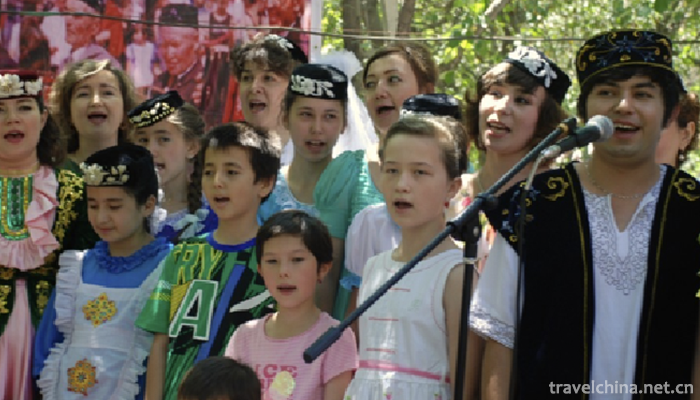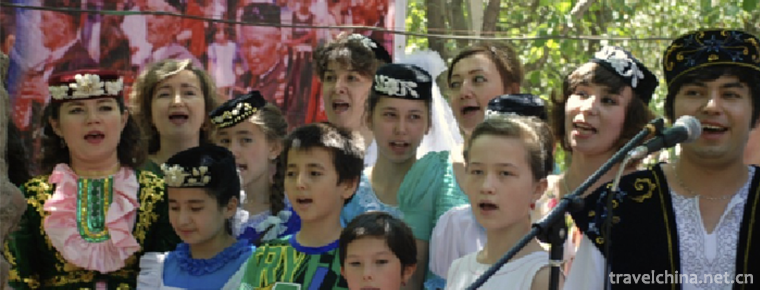Saban Festival of the Tatar Nationality
Saban Festival of the Tatar Nationality
The Saban Festival (also known as Ploughshare Festival) of the Tatar Nationality is a unique traditional festival of the Tatar Nationality. Every year, after the spring sowing of all the farmers in the village, the Tatar people hold a mass collective celebration. Tatar is called "Umaik" or "League Club". The celebration ceremony was held at the edge of the field. The main activities included wrestling, pole climbing, singing, dancing and running.
One of the earliest inscriptions of "Tatar" appeared in Erhunyesse. The Tatars in Xinjiang migrated from Kashan, Tiemiliqi and Zhaisang in the 19th century to settle in the northern part of Xinjiang. According to 2002 statistics, the Tatar population in Xinjiang is over 4700 people, mainly living in parts of northern and southern Xinjiang. On July 24, 1989, the first Tatar Autonomous Township was established in Daquan, Qitai County.
On June 7, 2008, the Saban Festival of the Tatar Nationality declared in Tacheng District of Xinjiang Uygur Autonomous Region was listed in the second batch of national intangible cultural heritage list with the approval of the State Council.
On May 23, 2011, the "Saban Festival of Tatar Nationality" declared by Qitai County of Xinjiang Uygur Autonomous Region was listed in the third batch of national intangible cultural heritage list with the approval of the State Council.
historical origin
Sarban is a happy and traditional festival. It is also a great display of Tatar costumes, diet, music, dance and games. Its content is very rich. The annual Sarban Festival, also known as the Plough Festival, is an important festival of the Tatar nationality. It is similar to the Spring Festival of the Han nationality. It is usually held during the busy farming period after spring ploughing. The time is about June 20-25, and there is no fixed date.
There are two theories about the origin of Sarban. Legend has it that "Saban" is the name of the wild plants growing in Central Asia. The ancestors of the Tartar nationality engaged in grazing and farming in history, and hunted at the same time.
Every spring and summer, when people return from grassland and farmland, they meet on the grassland beach where the grass is in full bloom, and carry out some cultural and sports activities. This ancient custom has been followed to this day. However, with the passage of time, the activities of our ancestors have been endowed with new content, which has become today's Sarban Festival full of folklore. Sarban Festival is also known as Plough Festival, because in the past, when Sarban Festival was held, it was the spring farming season.
In the bright spring season, people wear Festival dress, bring rich food, gather in pleasant suburban scenery, play national musical instruments, sing and dance, carry out various recreational activities, congratulate each other on the festival, also wish spring ploughing smoothly, hoping to get a bumper harvest of agriculture. Later, due to climate and environmental changes, the date of the festival changed and was postponed to the middle of June.
Sarban Festival is a festival entirely produced from production practice. This festival also reflects the simple thoughts of the Tatar people who love work and life, praise work and life.
Festival activities
Before the beginning of the festival, there is a ceremony of ploughing the field by a horse, dragging an ancient plough into the field as a plough. At this time, the host will speak and announce the beginning of the festival. At that time, people cheered and waited for the team that performed many literary and sports programs to enter. Before that, young Tatar men and women had rehearsed many times, waiting for the day to show their skills. Accompanied by accordion, Bayan, Mandalin and other instruments, people sang ancient "Guilla", "Sabantoy" and modern Tatar songs, and danced the Tatar dance. The content of the program is also rich, including small chorus, big chorus, instrument ensemble, collective dance and so on. When dancing, almost all men and women, old and young, go to battle together, eight immortals cross the sea, each showing its ability. People express their joy through their dancing and singing. Many Tatar families come on this day to give performances for you. The rich and colorful programs are so dazzling that people sing and dance to celebrate the festival.
The main festivals of the Tatar people are Meat Zi Festival and Gurban Festival. In addition, "Saban Festival" (also known as Ploughshare Festival, Ploughshare Festival) is a unique traditional festival of the Tatar people, "Saban Festival" (Ploughshare Festival) is an annual grand event, mostly held in beautiful places, such as singing and dancing, tug-of-war, and so on.
Horse racing, wrestling and other mass activities. Tatar is an agricultural nation, "Saban" and Kirgiz, meaning "celebrating spring ploughing". Every year after the end of spring ploughing, we celebrate the end of spring ploughing and hope for a prosperous autumn. This kind of celebration is called "Umaik" in Tatar, which is the "League Meeting". Villagers participate in the celebration. The celebrations are held in the fields or in the fields and presided over by prestigious elders. The main activities are wrestling, pole climbing, singing, dancing, racing, tug-of-war and horse racing. The winners will receive prizes such as handkerchiefs, scarves, embroidered shirts and so on. The main content of the festival is the couplet singing, adults singing hope for a bumper harvest; young people singing friendship and love; young people singing around the crowd: "Rain, rain, fast down, we should not be hungry, never see the plague like a lion." When the masses were singing, they also sang songs to teach lazy people: "Don't wander home quickly, turn wine bottles into horses, turn wine bottles into ploughs, and plant crops honestly."
Inheritance Significance
Sarban disappeared until 1986. When we study the age and season of ethnic minorities in Xinjiang, it is of great practical significance for us to study and sort out the Sarban Festival of the Tartar Nationality in order to develop production, strengthen national cohesion and promote social harmony.
Academically speaking, Sarban Festival is of great significance and value to the study of folklore, humanities and sociology, and should be protected and inherited.
Inheritance and Protection
The state and autonomous region invest nearly 20 million yuan annually in the protection of national traditional culture, such as "Xinjiang Uygur Mukam Art", "Uygur Daolang Maxirev", "Kazakh 62 Kuhner", "Kirgiz Kumzi Art", "Tajik Eagle Dance", "Xibo Westward Movement Festival" and "Tatar Sarban Festival". In the protection.
Intangible cultural heritage is an important gene of national cultural ecology. At the end of 2005, Xinjiang launched a survey of intangible cultural heritage with the longest history, the largest scale, the largest number of participants and the widest coverage. After the census, 3772 items of intangible cultural heritage resources in Xinjiang have been confirmed, of which more than 95% are ethnic minorities. Today, Xinjiang has 52 national intangible cultural heritage projects, 185 at the autonomous region level, 535 at the prefectural (prefectural, municipal) level and 2480 at the county (municipal) level. The state and Xinjiang governments allocate 10 million yuan annually to the protection of intangible cultural heritage of ethnic minorities in Xinjiang.
With the support of the Research Center for the Protection of Non-material Cultural Heritage in the Autonomous Region, in 2006 and 2008, 63 non-material cultural heritage projects in Xinjiang were listed in the first and second batches of national non-material cultural heritage lists.
Tatar folk traditional festivals: Tatar people believe in Islam, so like other brothers and nationalities who believe in Islam, the three major festivals are their main festivals. In addition, the Tatar people also celebrate the traditional festival of their own nation, Saban. Sarban Festival: also known as "Plough Festival", mostly held in beautiful places in spring. Tatars are good at singing and dancing, and love drama, music and singing and dancing. Tatar music has clear rhythm, flowing melody and short passion. The traditional instruments of the Tatar nationality include Muxiao and harmonica, as well as accordion, mandolin, seven-stringed Violin and other instruments. In all kinds of traditional festivals, we have to dance traditional dances. In the activities of singing and dancing, the traditional dancing habits of the Tatars are women playing male roles.


-
1.Longmen Grottoes Scenic Area
Longmen Grottoes is one of the treasure houses of Chinese stone carving art. It is now a world cultural heritage, a national key cultural relics protection unit and a national AAAAA class tourist attr
Time 2018-12-09 -
2.Bagong Mountain Tourist Scenic Area
Since 2001, Bagongshan Scenic Area has listed Bagongshan National Geopark, Bagongshan National Forest Park and Bagongshan National AAAA Tourist Area successively. Bagong Mountain is a famous historica
Time 2018-12-23 -
3.Longyu Bay National Forest Park
Longyuwan National Forest Park is located in Luanchuan County, Henan Province. It is 165 kilometers away from Luoyang City. It covers an area of 1833 hectares
Time 2019-02-06 -
4.The Site of the Ancient Great Wall of the Warring States Period
When people mention the Great Wall, they will think of the Great Wall from Shanhaiguan to Jiayuguan. However, in Xilingol League, there are also the ancient Great Wall, which is not as famous as the G
Time 2019-03-09 -
5.Tibetan Paper making Techniques
Tibetan paper-making technology, Tibetan Autonomous Region's traditional handicraft, one of the national intangible cultural heritage. Tibetan paper-making skills are usually made by peeling
Time 2019-04-15 -
6.Ma Xian Xing custom
The belief in Ma Xian is a traditional folk custom inherited from generation to generation by the people of Fujian and Zhejiang. Ma Xian, also known as Ma Xiaoxian, is a goddess worshipped in northeas
Time 2019-05-16 -
7.Mongolian Medicine
Mongolian medicine is mainly moxibustion, and is good at using fire needles. Fire needle is a method of treating diseases by rapidly puncturing the acupoints with red-hot needle tips. This method has
Time 2019-06-04 -
8.Making Skills of Sheng Xifu Leather Cap
Shengxifu leather cap production skills need to go through the whole process from matching, picking, blowing, brushing, flat leather, shaving, hand needle sewing to machine sewing, and finally complet
Time 2019-06-14 -
9.Neutralization Festival
Zhonghe Festival, a traditional Chinese folk festival, is on the second day of February, but the date at that time was on the first day of February. With the evolution of history, it was changed to th
Time 2019-08-03 -
10.Chengdu University of Technology
Chengdu University of Technology was founded on March 15, 1956 and approved by the State Council. On March 27, the Ministry of Higher Education and the Ministry of Geology jointly issued a paper based
Time 2019-08-31 -
11.The world is so big still meet you Cheng Xiang Tik Tok Songs 2020 Hot Songs
"The world is so big still meet you " is composed by htet Aung Lwin and sung by Cheng Xiang. It is the Chinese version of myanmar music "for Ma". It was officially released on Janu
Time 2020-05-21 -
12.Tips for Chengdu TourismTime 2020-11-28